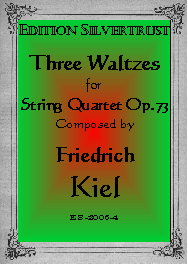Presents
Friedrich Kiel
Three Waltzes for String Quartet, Op.73
 Writing
of the chamber music of Friedrich Kiel (1821-1885), Wilhelm Altmann—perhaps the
greatest of chamber music critics—notes that it was Kiel’s extreme modesty which
kept him and his exceptional works from receiving the consideration they
deserved. And what consideration did Altmann feel these works deserved? After
mentioning Brahms and others, Altmann writes, “He produced a number of chamber
works, which...need fear no comparison.” Altmann, himself, said that he found in
Kiel’s chamber music a “never ending source of delight.”
Writing
of the chamber music of Friedrich Kiel (1821-1885), Wilhelm Altmann—perhaps the
greatest of chamber music critics—notes that it was Kiel’s extreme modesty which
kept him and his exceptional works from receiving the consideration they
deserved. And what consideration did Altmann feel these works deserved? After
mentioning Brahms and others, Altmann writes, “He produced a number of chamber
works, which...need fear no comparison.” Altmann, himself, said that he found in
Kiel’s chamber music a “never ending source of delight.”
Kiel was taught the rudiments of music and received his first piano lessons from his father but was in large part self-taught. Something of a prodigy, he played the piano almost without instruction at the age of six, and by his thirteenth year he had composed much music. Kiel eventually came to the attention of Prince Wittgenstein, a great music lover. Through the Prince's efforts, Kiel was allowed to study violin with the concertmaster of the Prince’s fine orchestra with which he later performed as a soloist. Kiel was also given theory lessons from the renowned flautist Kaspar Kummer. By 1840, the eighteen year old Kiel was court conductor and the music teacher to the prince’s children. Two years later, Spohr heard him and arranged for a scholarship which allowed Kiel to study in Berlin with the renowned theorist and teacher Siefried Dehn. In Berlin, Kiel eventually became sought after as an instructor. In 1866, he received a teaching position at the prestigious Stern Conservatory, where he taught composition and was elevated to a professorship three years later. In 1870 he joined the faculty of the newly founded Hochschule für Musik which was shortly thereafter considered one of the finest music schools in Germany. Among his many students were Noskowski, Paderewski and Stanford. Kiel's hobby was mountaineering and at age 60--two years before his tragic death as the result of a traffic accident--he climbed Europe's second highest peak, Monte Rosa.
These Three Waltzes are not lightweight, salon music but perhaps the finest set of waltzes for string quartet written, this extraordinary music deserves to be heard and played. Any of the three would make an outstanding encore for a professional group and all three would serve nicely where a shorter work is required. The first waltz has both lyrical, exposive and haunting episodes. The second waltz alternates from rich, full-blooded tunes, to light and delicate melodies. Of particular interest is that it includes a long solo section for cello while the others rest. The charming third waltz combines elements of the preceding two.
Parts: $24.95